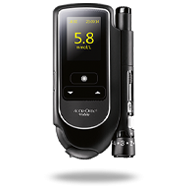There will be meters with different serial numbers as U10xxxxxxxx or U11xxxxxxxx that differ in E-3 error message and show a new E-5 error message.
Serial number: with U10xxxxxxxx
Your blood glucose value may be very low.
If the way you feel agrees with a very low blood glucose value, immediately follow the relevant instructions given by your healthcare professional. Repeat the test afterwards.
A meter error has occurred. If the error message is still displayed after turning the meter on again, please contact Accu-Chek Enquiry Line 1800 251 816.
The primary reason for the error message in the meter with serial number U1000xxx is incorrect blood application.
Serial number: with U11xxxxxxxx
Your blood glucose value may be very low.
If a very low blood glucose value matches how you feel, follow the relevant instructions given by your healthcare professional immediately. Repeat the test afterwards.
A meter error has occurred or the meter is defective.
If the error message is still displayed after turning the meter on again, contact Accu-Chek Enquiry Line 1800 251 816. The meter may be defective.
